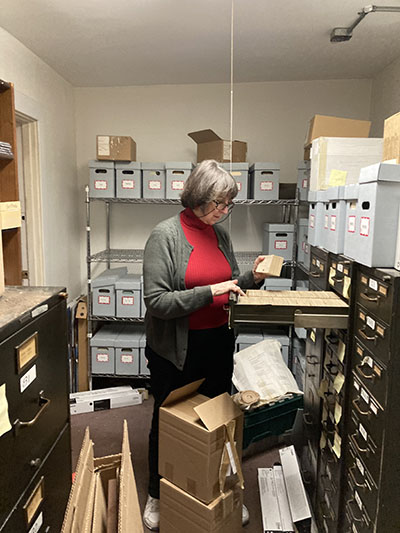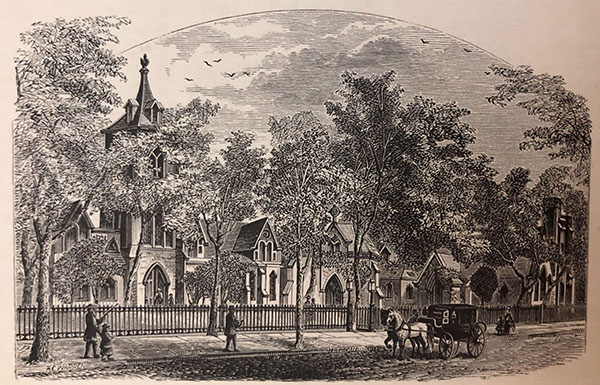The NYG&B’s latest collection, Church of the Transfiguration, is an ongoing, monumental project, and a key part of our Digitize New York initiative. Through this initiative, the NYG&B is partnering with organizations across New York State to preserve at-risk historical records and make them publicly accessible.
Organizations can either submit their records for preservation at one of the NYG&B’s Digitization Centers or request a digitization kit that empowers them to preserve and upload records at their own sites—at no cost to participating organizations.

The Church of the Transfiguration, an Episcopalian parish located in the Manhattan borough of New York City, became one of the NYG&B’s first organizational partners to participate in Digitize New York, beginning in 2022.
Founded in 1848, the church—which was made a national landmark in 1973—has a fascinating story, with an original mission to serve the poor and marginalized and a long history of many services performed that have endured over two centuries and into today.
Known more colloquially as the “Little Church Around the Corner,” the church proclaims to have performed the most marriages in New York City. This is quite a feat, especially when compared with the size and resources of other larger parishes in New York City. With collections comprising tens of thousands of marriage records as well as bound register volumes of other religious records (including baptisms and confirmations), this assertion is certainly a believable one. Such a vast trove of important and invaluable historical records made the Church of the Transfiguration a perfect partner to begin our Digitize New York work.
Two years on, this ongoing, collaborative project has been a great source of learning for achieving the NYG&B’s goals for Digitize New York; working together to navigate any bumps in the road; and developing and implementing innovative ideas to ensure a project’s success.
Before undertaking any Digitize New York project, the NYG&B first maps out and assesses each element of the proposed project. We need to thoroughly consider the scale, scope, and the realities of a project so we can give the partner organization an appropriate timeline as well as determine how to best deploy our volunteers, who play a key role in the operations and progress of Digitize New York. After being vetted and trained by NYG&B staff, volunteers scan records and assist with indexing and material assessments. All three of these key players—the NYG&B, partner organization, and volunteers—need to feel that the plan is rock solid.

As with any long-term, multi-partner project, it's important to remain flexible and open to necessary shifts in processes and expectations. Throughout our partnership with the Church of the Transfiguration, we’ve made some significant adjustments that have resulted in more efficient workflows and have helped to further clarify the end goal.
From the start and because of the immense number of historical materials that the church held, we knew that we wanted to offer record releases on an ongoing basis, prior to the completion of the project as a whole. We also understood that indexing the records was going to be both a necessity and a major challenge. Our typical process has been to schedule indexing to come after the scanning and digital processing of documents. However, this typical staging of steps would not enable us to meet our first goal of releasing records sooner rather than later.
From the onset, we got a head start on indexing by sending two of our long-time volunteers, Deborah Barber and Lynne Hayden-Findlay, to the church each week to input information from index cards that matched the bound volumes we were scanning. After almost two years of dedicated weekly indexing, the volunteers are reaching the finishing line on this aspect of the index.
When it came time to start indexing the vast number of marriage certificate files, we first began in-house, as is our norm. This would typically involve one indexer at a time spending a couple of hours in our NYG&B office transcribing information from an image to a spreadsheet. But we quickly realized that the minimal amount of in-house indexing we could complete each week would also make reaching our release goal extremely difficult.
This challenge inspired us to explore how we could work on indexing with remote volunteers, which has since become an integral part of our process. We are now working with upwards of 20 volunteers indexing the project remotely, which has allowed us to begin offering a substantial, steady, and realistic pipeline of monthly releases for the Church of the Transfiguration records, which we expect to go on well into 2025.
The Church of the Transfiguration project has emerged as a model for how the NYG&B approaches and continuously tailors our projects under the Digitize New York initiative. When we are collaborating on multi-year projects, we can expect instances where we will have to shift and adapt to approaches that best suit the project. Our work in doing so with the Church of the Transfiguration has taught us how to respond nimbly.

In addition to being a model for our digital preservation and access work, this project has a treasure trove of fascinating materials to offer the genealogical community. The inclusion of these tens of thousands of records to our online collections perfectly aligns with our mission. The immense scale and demographic breadth of this collection becomes overwhelming in the best of ways. What we might first think of as some records from a “little church” on the east side of Manhattan has emerged as an expansive collection that represents the melting pot of New York City and beyond for researchers. The world can truly be found in the Church of the Transfiguration collection.
The NYG&B’s collaboration with the Church of the Transfiguration has been an incredibly instructive experience. The innovative methods we implemented and which brought this type of online collection to fruition have helped pave the way for our Digitize New York initiative. And by providing open, searchable access to a collection of this scale, the NYG&B has made available a tremendously useful model and resource for the genealogy and family history community.